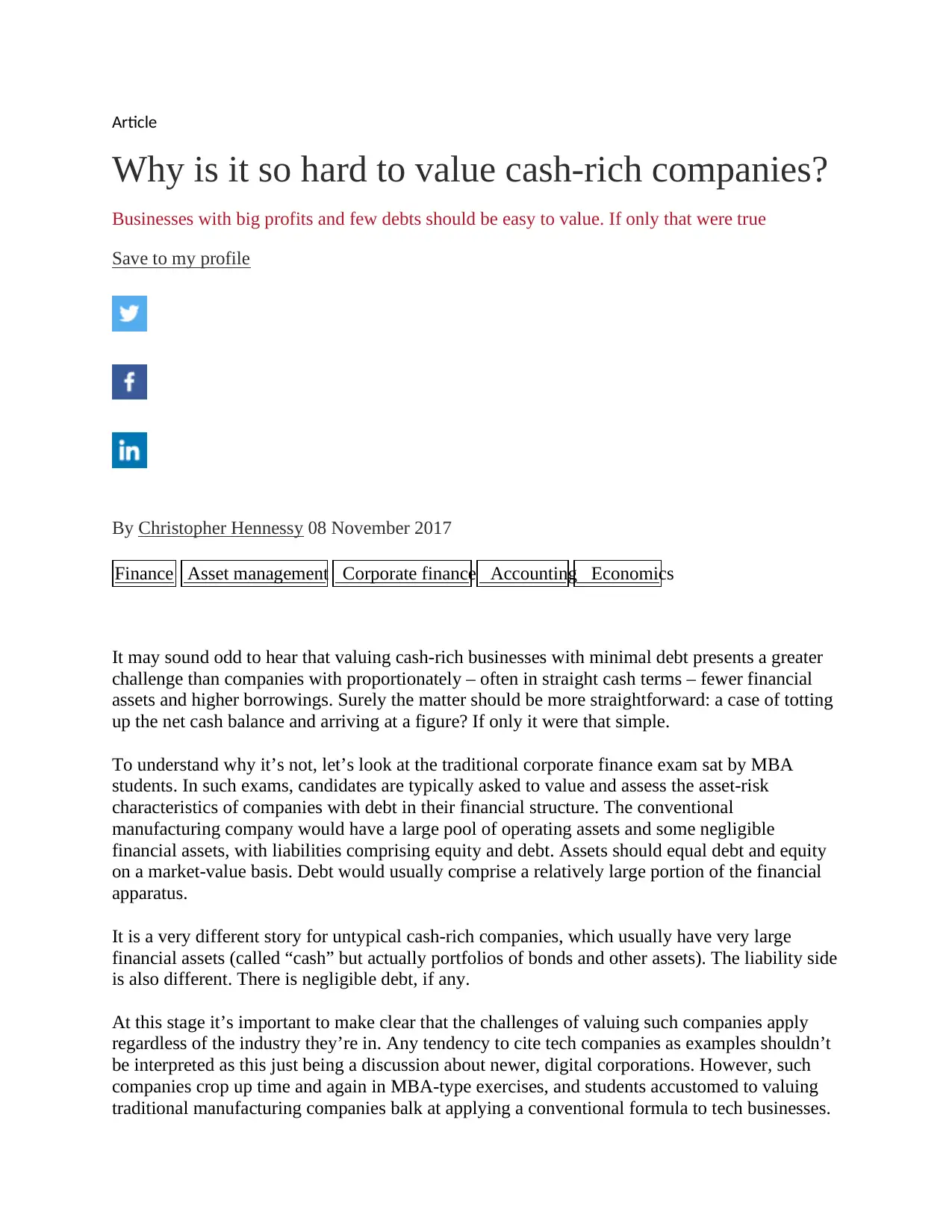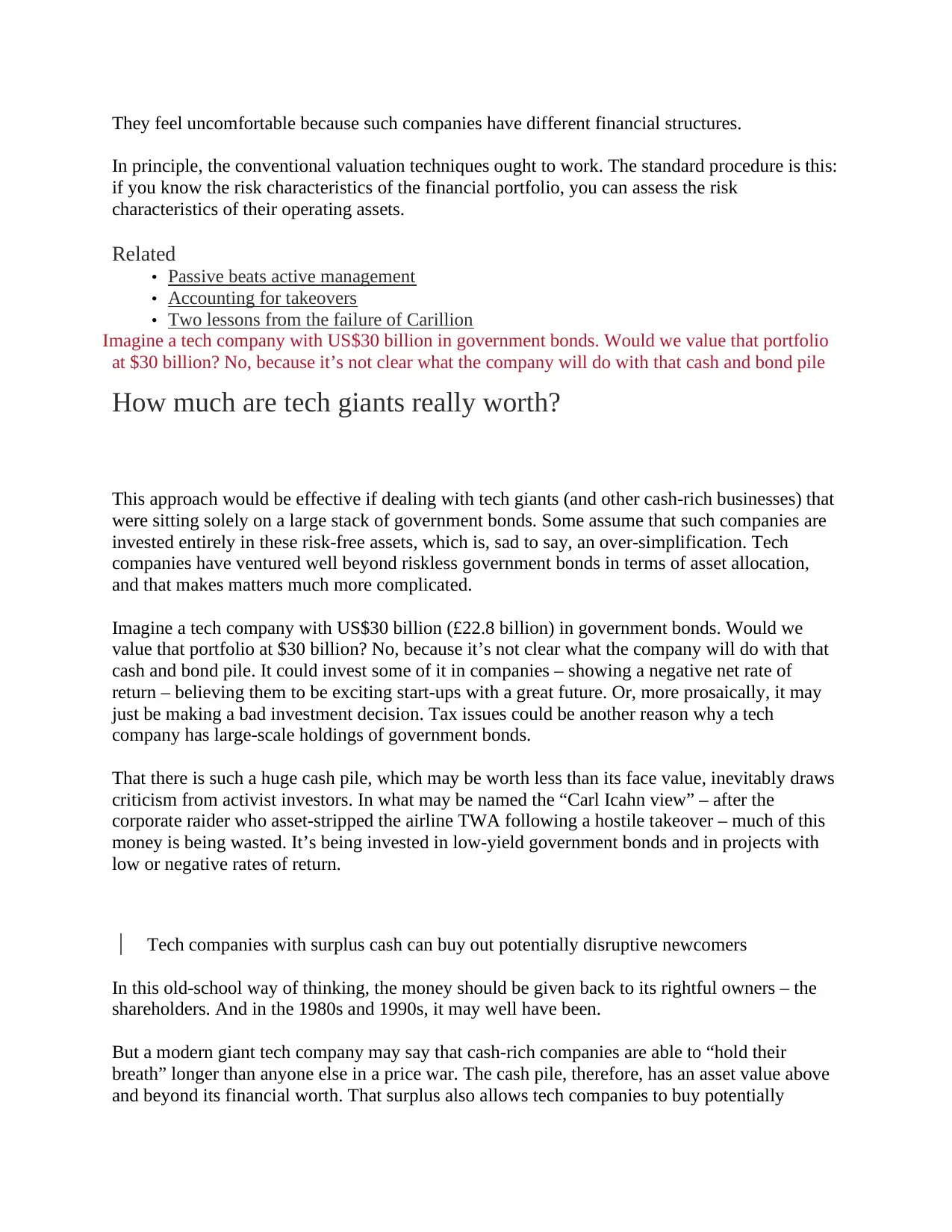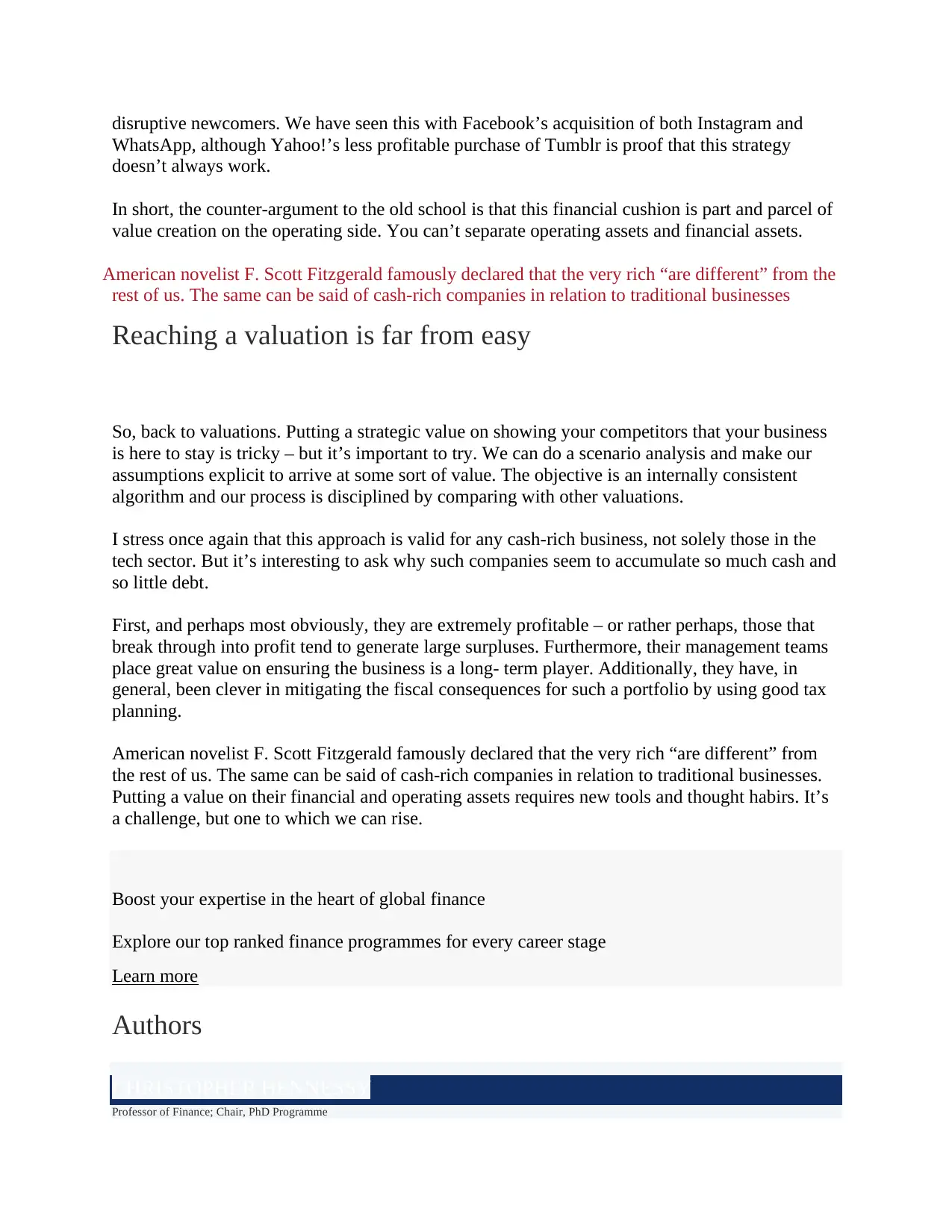Valuation of Cash-Rich Companies: A Corporate Finance Perspective
VerifiedAdded on 2023/06/12
|4
|1237
|260
Report
AI Summary
This report delves into the complexities of valuing cash-rich companies, highlighting that traditional valuation methods often fall short due to the unique financial structures and investment strategies of these firms. It addresses the challenges posed by large financial asset holdings, negligible debt, and the diverse asset allocations beyond risk-free government bonds. The report also examines the strategic value of holding substantial cash reserves, enabling companies to withstand price wars and acquire potentially disruptive newcomers. Furthermore, it emphasizes the importance of considering tax implications and the potential for activist investor criticism. By advocating for scenario analysis and explicit assumptions, the report provides a framework for reaching a more accurate valuation of cash-rich businesses, underscoring that this approach is not limited to the tech sector but applicable to any company with significant cash reserves. Desklib provides access to similar solved assignments and past papers for students.

Article
Why is it so hard to value cash-rich companies?
Businesses with big profits and few debts should be easy to value. If only that were true
Save to my profile
By Christopher Hennessy 08 November 2017
Finance Asset management Corporate finance Accounting Economics
It may sound odd to hear that valuing cash-rich businesses with minimal debt presents a greater
challenge than companies with proportionately – often in straight cash terms – fewer financial
assets and higher borrowings. Surely the matter should be more straightforward: a case of totting
up the net cash balance and arriving at a figure? If only it were that simple.
To understand why it’s not, let’s look at the traditional corporate finance exam sat by MBA
students. In such exams, candidates are typically asked to value and assess the asset-risk
characteristics of companies with debt in their financial structure. The conventional
manufacturing company would have a large pool of operating assets and some negligible
financial assets, with liabilities comprising equity and debt. Assets should equal debt and equity
on a market-value basis. Debt would usually comprise a relatively large portion of the financial
apparatus.
It is a very different story for untypical cash-rich companies, which usually have very large
financial assets (called “cash” but actually portfolios of bonds and other assets). The liability side
is also different. There is negligible debt, if any.
At this stage it’s important to make clear that the challenges of valuing such companies apply
regardless of the industry they’re in. Any tendency to cite tech companies as examples shouldn’t
be interpreted as this just being a discussion about newer, digital corporations. However, such
companies crop up time and again in MBA-type exercises, and students accustomed to valuing
traditional manufacturing companies balk at applying a conventional formula to tech businesses.
Why is it so hard to value cash-rich companies?
Businesses with big profits and few debts should be easy to value. If only that were true
Save to my profile
By Christopher Hennessy 08 November 2017
Finance Asset management Corporate finance Accounting Economics
It may sound odd to hear that valuing cash-rich businesses with minimal debt presents a greater
challenge than companies with proportionately – often in straight cash terms – fewer financial
assets and higher borrowings. Surely the matter should be more straightforward: a case of totting
up the net cash balance and arriving at a figure? If only it were that simple.
To understand why it’s not, let’s look at the traditional corporate finance exam sat by MBA
students. In such exams, candidates are typically asked to value and assess the asset-risk
characteristics of companies with debt in their financial structure. The conventional
manufacturing company would have a large pool of operating assets and some negligible
financial assets, with liabilities comprising equity and debt. Assets should equal debt and equity
on a market-value basis. Debt would usually comprise a relatively large portion of the financial
apparatus.
It is a very different story for untypical cash-rich companies, which usually have very large
financial assets (called “cash” but actually portfolios of bonds and other assets). The liability side
is also different. There is negligible debt, if any.
At this stage it’s important to make clear that the challenges of valuing such companies apply
regardless of the industry they’re in. Any tendency to cite tech companies as examples shouldn’t
be interpreted as this just being a discussion about newer, digital corporations. However, such
companies crop up time and again in MBA-type exercises, and students accustomed to valuing
traditional manufacturing companies balk at applying a conventional formula to tech businesses.
Paraphrase This Document
Need a fresh take? Get an instant paraphrase of this document with our AI Paraphraser

They feel uncomfortable because such companies have different financial structures.
In principle, the conventional valuation techniques ought to work. The standard procedure is this:
if you know the risk characteristics of the financial portfolio, you can assess the risk
characteristics of their operating assets.
Related
• Passive beats active management
• Accounting for takeovers
• Two lessons from the failure of Carillion
Imagine a tech company with US$30 billion in government bonds. Would we value that portfolio
at $30 billion? No, because it’s not clear what the company will do with that cash and bond pile
How much are tech giants really worth?
This approach would be effective if dealing with tech giants (and other cash-rich businesses) that
were sitting solely on a large stack of government bonds. Some assume that such companies are
invested entirely in these risk-free assets, which is, sad to say, an over-simplification. Tech
companies have ventured well beyond riskless government bonds in terms of asset allocation,
and that makes matters much more complicated.
Imagine a tech company with US$30 billion (£22.8 billion) in government bonds. Would we
value that portfolio at $30 billion? No, because it’s not clear what the company will do with that
cash and bond pile. It could invest some of it in companies – showing a negative net rate of
return – believing them to be exciting start-ups with a great future. Or, more prosaically, it may
just be making a bad investment decision. Tax issues could be another reason why a tech
company has large-scale holdings of government bonds.
That there is such a huge cash pile, which may be worth less than its face value, inevitably draws
criticism from activist investors. In what may be named the “Carl Icahn view” – after the
corporate raider who asset-stripped the airline TWA following a hostile takeover – much of this
money is being wasted. It’s being invested in low-yield government bonds and in projects with
low or negative rates of return.
Tech companies with surplus cash can buy out potentially disruptive newcomers
In this old-school way of thinking, the money should be given back to its rightful owners – the
shareholders. And in the 1980s and 1990s, it may well have been.
But a modern giant tech company may say that cash-rich companies are able to “hold their
breath” longer than anyone else in a price war. The cash pile, therefore, has an asset value above
and beyond its financial worth. That surplus also allows tech companies to buy potentially
In principle, the conventional valuation techniques ought to work. The standard procedure is this:
if you know the risk characteristics of the financial portfolio, you can assess the risk
characteristics of their operating assets.
Related
• Passive beats active management
• Accounting for takeovers
• Two lessons from the failure of Carillion
Imagine a tech company with US$30 billion in government bonds. Would we value that portfolio
at $30 billion? No, because it’s not clear what the company will do with that cash and bond pile
How much are tech giants really worth?
This approach would be effective if dealing with tech giants (and other cash-rich businesses) that
were sitting solely on a large stack of government bonds. Some assume that such companies are
invested entirely in these risk-free assets, which is, sad to say, an over-simplification. Tech
companies have ventured well beyond riskless government bonds in terms of asset allocation,
and that makes matters much more complicated.
Imagine a tech company with US$30 billion (£22.8 billion) in government bonds. Would we
value that portfolio at $30 billion? No, because it’s not clear what the company will do with that
cash and bond pile. It could invest some of it in companies – showing a negative net rate of
return – believing them to be exciting start-ups with a great future. Or, more prosaically, it may
just be making a bad investment decision. Tax issues could be another reason why a tech
company has large-scale holdings of government bonds.
That there is such a huge cash pile, which may be worth less than its face value, inevitably draws
criticism from activist investors. In what may be named the “Carl Icahn view” – after the
corporate raider who asset-stripped the airline TWA following a hostile takeover – much of this
money is being wasted. It’s being invested in low-yield government bonds and in projects with
low or negative rates of return.
Tech companies with surplus cash can buy out potentially disruptive newcomers
In this old-school way of thinking, the money should be given back to its rightful owners – the
shareholders. And in the 1980s and 1990s, it may well have been.
But a modern giant tech company may say that cash-rich companies are able to “hold their
breath” longer than anyone else in a price war. The cash pile, therefore, has an asset value above
and beyond its financial worth. That surplus also allows tech companies to buy potentially

disruptive newcomers. We have seen this with Facebook’s acquisition of both Instagram and
WhatsApp, although Yahoo!’s less profitable purchase of Tumblr is proof that this strategy
doesn’t always work.
In short, the counter-argument to the old school is that this financial cushion is part and parcel of
value creation on the operating side. You can’t separate operating assets and financial assets.
American novelist F. Scott Fitzgerald famously declared that the very rich “are different” from the
rest of us. The same can be said of cash-rich companies in relation to traditional businesses
Reaching a valuation is far from easy
So, back to valuations. Putting a strategic value on showing your competitors that your business
is here to stay is tricky – but it’s important to try. We can do a scenario analysis and make our
assumptions explicit to arrive at some sort of value. The objective is an internally consistent
algorithm and our process is disciplined by comparing with other valuations.
I stress once again that this approach is valid for any cash-rich business, not solely those in the
tech sector. But it’s interesting to ask why such companies seem to accumulate so much cash and
so little debt.
First, and perhaps most obviously, they are extremely profitable – or rather perhaps, those that
break through into profit tend to generate large surpluses. Furthermore, their management teams
place great value on ensuring the business is a long- term player. Additionally, they have, in
general, been clever in mitigating the fiscal consequences for such a portfolio by using good tax
planning.
American novelist F. Scott Fitzgerald famously declared that the very rich “are different” from
the rest of us. The same can be said of cash-rich companies in relation to traditional businesses.
Putting a value on their financial and operating assets requires new tools and thought habirs. It’s
a challenge, but one to which we can rise.
Boost your expertise in the heart of global finance
Explore our top ranked finance programmes for every career stage
Learn more
Authors
CHRISTOPHER HENNESSY
Professor of Finance; Chair, PhD Programme
WhatsApp, although Yahoo!’s less profitable purchase of Tumblr is proof that this strategy
doesn’t always work.
In short, the counter-argument to the old school is that this financial cushion is part and parcel of
value creation on the operating side. You can’t separate operating assets and financial assets.
American novelist F. Scott Fitzgerald famously declared that the very rich “are different” from the
rest of us. The same can be said of cash-rich companies in relation to traditional businesses
Reaching a valuation is far from easy
So, back to valuations. Putting a strategic value on showing your competitors that your business
is here to stay is tricky – but it’s important to try. We can do a scenario analysis and make our
assumptions explicit to arrive at some sort of value. The objective is an internally consistent
algorithm and our process is disciplined by comparing with other valuations.
I stress once again that this approach is valid for any cash-rich business, not solely those in the
tech sector. But it’s interesting to ask why such companies seem to accumulate so much cash and
so little debt.
First, and perhaps most obviously, they are extremely profitable – or rather perhaps, those that
break through into profit tend to generate large surpluses. Furthermore, their management teams
place great value on ensuring the business is a long- term player. Additionally, they have, in
general, been clever in mitigating the fiscal consequences for such a portfolio by using good tax
planning.
American novelist F. Scott Fitzgerald famously declared that the very rich “are different” from
the rest of us. The same can be said of cash-rich companies in relation to traditional businesses.
Putting a value on their financial and operating assets requires new tools and thought habirs. It’s
a challenge, but one to which we can rise.
Boost your expertise in the heart of global finance
Explore our top ranked finance programmes for every career stage
Learn more
Authors
CHRISTOPHER HENNESSY
Professor of Finance; Chair, PhD Programme
⊘ This is a preview!⊘
Do you want full access?
Subscribe today to unlock all pages.

Trusted by 1+ million students worldwide

He teaches on the following programmes:
• Corporate Finance Porftolio
• Masters in Financial Analysis
• MBA
• Masters in Finance
• PhD
• Corporate Finance Porftolio
• Masters in Financial Analysis
• MBA
• Masters in Finance
• PhD
1 out of 4
Related Documents
Your All-in-One AI-Powered Toolkit for Academic Success.
+13062052269
info@desklib.com
Available 24*7 on WhatsApp / Email
![[object Object]](/_next/static/media/star-bottom.7253800d.svg)
Unlock your academic potential
Copyright © 2020–2025 A2Z Services. All Rights Reserved. Developed and managed by ZUCOL.





